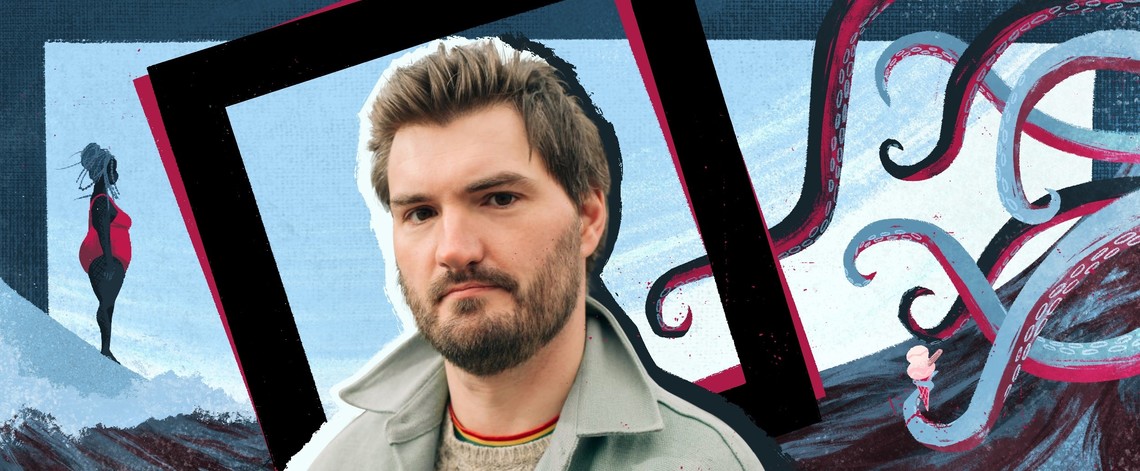
In early 2020, playwrights Andrew Thompson and Morna Young undertook month-long residencies in Japan with the aim of producing a full-length work for the stage as part of the British Council's 'Scotland in Japan' project and Creative Scotland's UK/Japan Season of Culture 2019-2020.
With restrictions over the last year making physical performances challenging, Andrew honed in on a single aspect of his larger idea to play with and explore in I ❤️🍦 - an experimental monologue that takes a surreal deep dive into themes of abuse, misogyny and folklore. Available to watch now with English and Japanese subtitles.
In this blog, Andrew gives an insight into the page to stage process behind I ❤️🍦 and how he found a way to distil his larger idea into this digital presentation.
The Japanese translation of this blog was provided by Nao Miyauchi.
I’m staring at a screen. I’m sat in my house and I’m staring at a screen watching an actor wearing a pink fluorescent swimming cap pretend to lick an invisible blood-soaked ice cream. Even I’m not sure how we got here.
A year ago I was given the most incredible opportunity. The Traverse, in conjunction with The British Council, were supporting me to travel across Japan and research my ideas. I had proposed a play infused with politics, fantasy and mythology and now I was standing, surrounded by life, in the middle of Tokyo. Driving through the abandoned lives of Fukushima. Absorbing the weight of life in Hiroshima, and witnessing the protection of living things in Ise. I was meeting people and being introduced to so much culture, tradition, and the human response to truly epic disaster of both man and natural making. Returning home to distil all this into my work felt like both a challenge and a gift.
And then the world tilted on its axis. The very idea of ever getting to carry out the sort of journey I had just done disappeared into a painfully distant future. The very idea of theatre disappeared into an equally distant agony.
私は今スクリーンを見つめています。家の中で座って、スクリーンを見つめ、蛍光ピンクの水泳帽をかぶった俳優が、目に見えない血まみれのアイスクリームを舐めるふりをしているのを見ています。なぜこんなことになっているのか、私にもよくわかりません。
一年前、私は素晴らしいチャンスを与えられました。トラバース劇場とブリティッシュカウンシルから、日本を旅してリサーチをするためのサポートを受けることになったのです。政治と空想、神話を融合したような作品を提案した私は、東京の真ん中で、さまざまな人生に囲まれて立ち尽くしていました。捨て置かれた福島の人生の間を車で駆け抜けました。広島の人生の重みを吸収し、伊勢で生物の保護を目撃しました。多くの人に出会い、文化や伝統、人類と自然による大災害に対する人間の反応を知りました。帰国して、これらのことすべてを作品に反映させるのは、挑戦であると同時にギフトでもあると感じました。
そして、世界は大きく傾くこととなりました。私が今しがた行ってきたような旅に出ることを考えることすら、ひどく遠い未来の果てへと消えてしまったのです。演劇というものすらも、同じように遥か彼方の苦悩の中に消え去りました。

The idea of writing a large-scale, cross-cultural entertainment for people to gather and watch together felt futile to me, but thankfully not to the Traverse. They very quickly got in touch to say ‘we don’t know what’s happening, we don’t know what’s possible, but what can we do to keep this going?’. And to know that the idea of ‘maybe one day’ still existed was a hugely motivating factor in making me find a way.
As part of this they suggested an online sharing of the work. A scene, a moment, something from the play that gave a taste but translated to a digital setting. It didn’t feel right, to me, to try and lift something from an unfinished play and attempt to put it on its feet (or in this case screen) for public consumption. So I suggested I write something new. Unique. Something that spoke to the ideas of the larger work but that might help me in the process of bringing the bigger script into focus, while still being a something in its own right.
人々が集まって一緒に楽しめるような、スケールの大きい異文化エンターテインメント作品を執筆するという考えは、私にはもはや無益なもののように思えましたが、ありがたいことにトラバース劇場にとってはそうではありませんでした。彼らはすぐに連絡をくれて、「これからどうなるかわからないし、何ができるかわからないけれど、これを続けていくために私たちに何ができるでしょう?」と言ってくれました。そして「いつかきっと」という可能性が残っていたことが、私にとっては前に進んでいく大きなモチベーションとなりました。
劇場側から提案されたアイディアの一部が、オンラインで作品を共有するということでした。シーンでも、どこかの瞬間でも、作品の雰囲気を伝える何かをデジタルに置き換えて届けるというものです。ただ私にとっては、まだ出来上がっていない作品を持ち上げて、人々に見てもらうために足を(この場合はスクリーンを)与えるというのは正しくないことに思えました。ですので、何か新しいものを書くことを提案しました。ユニークなもの。大きな作品のアイディアを伝えながら、私がこ
れから脚本をフォーカスさせていくプロセスの手助けとなりつつ、それだけでも成立するような何かを。

We talked about how we might stage the piece, what does/could digital theatre look like. I decided I wanted it to be a ‘play’ but that I wanted to capture the theatricality of live theatre, the accepted artifice of it. We would film in the theatre, on the stage. The actor would perform to the auditorium and we would replace sets, costumes etc. with animation.
The first stumbling block was that we couldn’t enter the theatre. The Traverse, sensibly, have a policy against making people travel to or enter their building. Fine. The actor would work from home.
The second stumbling block was… there was no second stumbling block. Don’t get me wrong, there were and are plenty of problems to overcome, some of which have yet to be solved, and I’ve no idea at the time of writing this what the final outcome and piece will be, but it will be. And at this moment that in itself feels like a victory.
作品をどう上演するか、デジタルの演劇というのがどのようなものになるのかを私たちは話し合いました。私はこれを、“演劇”でありながら、生の演劇の劇場性とその手法を捉えられるようなものにしたい、と決めました。劇場で、舞台の上で撮影をする、俳優は客席に向かって演じ、アニメーションを使いながら、セットや衣装の転換もする、というものです。
最初の壁は、劇場に入ることを許されないということでした。トラバース劇場は、劇場に人を来させたり、建物に入ったりすることを認めないポリシーを決めていました。仕方ありません。俳優は自宅から参加することになりました。
ふたつめの壁は・・・ふたつめの壁がないということでした。もちろんたくさん問題はありましたし、解決策も見えていないような問題はまだまだあります。これを書いている時点で最終的な作品がどんなものになるかまったく見えていません。でも作品はできあがるでしょう。そして今現在それ自体がもう勝利のように思えるのです。
I ❤️🍦is supported by British Council Scotland, the Scottish Government and The Great Britain Sasakawa Foundation.
The Traverse Theatre is funded by Creative Scotland and The City of Edinburgh Council, with additional support from The Scottish Government Performing Arts Venues Relief Fund.
Image: Alex Harwood





